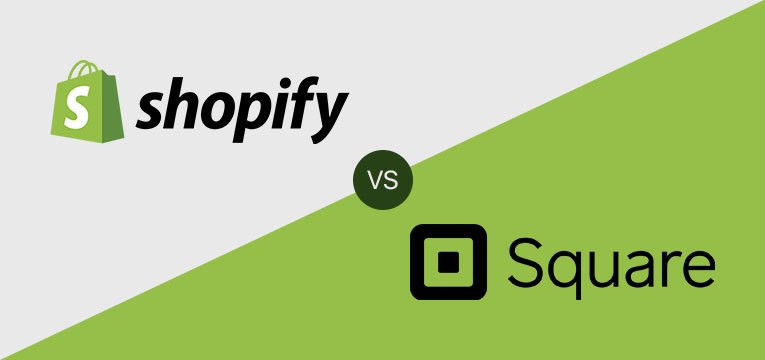Shopify Vs Square: A Comprehensive Guide for Choosing the Right POS
Have you ever wondered why profits remain at one’s disposal for eCommerce retailers? In fact, due to the meteoric rise, the sales are expected to quadruple within a decade. With intimidating ecommerce features like same-day conveyance, long-tail item combination, and free returns, clients have begun rethinking their purchasing alternatives. In a nutshell, nothing can stop this new landscape from growing.
If you ask us to define eCommerce profitability? We would say that it doesn’t resemble a straight line; it’s more like a rhythm strip (featuring many ups and downs/ twists and turns). But here’s the big question, how to boost the bottom line? After all, one doesn’t want to have an adverse effect on the top line right or at least be able to minimize the damage.
Now numerous solutions are prevailing in the online market amongst which many are taken from the books of brick-and-mortar stores, for example, many hybrid entrepreneurs are found settling for the right Shopify development services and POS systems categorized into two i.e. Shopify vs Square. The following post acts as a comprehensive guide on choosing the right one for your online store too. Of course, Obviously, you will discover more than a hundred shopping baskets, POS solutions and versatile third party apps open to the expected vendor, yet none as famous and as effective as Shopify and Square.
1. Introducing POS Systems
Define a POS system. The Point of Sale system has itself been an era of conducting transactions with the use of technology. If simply put, a creative mix of programming and equipment enabling customers to make secure, and credit payments right at the moment. Accordingly, retailers get the opportunity to hit the bull’s eye by holding clients, improving the buying experience, rearranging value customization for each item, keeping the history of past buys which are supposed to be investigated later on, and so on. All these are signs that anytime soon you might have to bid adieu to your existing cash registers.
What’s so interesting about a POS system? It is utilized to streamline all the cashless transactions and keep records. The key highlights include billing and order preparing, stock administration, cross channel returns, client relationship and experience, deals observing, sales monitoring and reporting, representative administration, loyalty programs and gift vouchers. Further underneath we might want to focus on the movement at which organizations have and are intending to receive POS frameworks for different reasons.
#1 Roll offers and makes a success win circumstance for you and your client. A POS framework that presents complete stock data as well as facilitates the age of arrangements, coupons, offers, is the best to choose. At long last, you will get a clear idea regarding what impact a specific offer rollout has had on your all-out deals.
#2 Time spent on the heads is lessened by and large. A very much introduced POS system gives applicable reports to help oversee and settle on occasional benefit deciding. By doing this, you will have the option to decrease superfluous hours spent on modest authoritative errands and opens up the proprietor’s an ideal opportunity to zero in on the centre business.
#3 Security is another significant explanation on the grounds that no retailer can’t risk a delicate snippet of information which turns out to be at high risk, and permit programmers (the bad guys) to get a simple pass to take client data. The advanced age POS system is based on a very intense and complex calculation that deals with escape clauses to evade information burglary and secures the end-client.
However, this isn’t it! There are a lot of different advantages to utilizing online systems, for example, stock control benefits, improved client support, showcasing benefits, and coordinated online stores.
The best Point Of Sale systems of 2021 include:
- Shopify – Best for loyalty
- Square – Best for new business owners
- Quickbooks – Best for Quickbooks customers
- ShopKeep – Best for small Businesses and online businesses
- Vend – Most bang for your buck
2. Shopify
We all know that Shopify is highly recommended as an eCommerce solution but what you may not know is that the e commerce platform can act as a fantastic Point Of Sale service for retailers. As a matter of fact, more than 1 million businesses are found using Shopify’s POS system for their sales needs.
If you want to create customers for life, choose Shopify development. All you have to do is choose a reputable Shopify development company that offers convenient services, and you are sorted. With key features like their completely synchronized client profiles – the stage permits you to use things like past requests, lifetime spends, and any notes about them to give individuals a completely customized shopping experience.
In addition, one gets boundless data transmission on this stage, where a vast number of things can be sold. Other than this, if the dealer doesn’t have a custom domain to move then it tends to be purchased through Shopify app store. However, that’s not compulsory as it can be bought from different sources. Scalability and flexibility are what works wonders here.
There is just a single issue: Unlike Square, Shopify doesn’t accompany its own loyalty-based program. Rather, they offer a wide range of applications from third-party programs. Well is it acceptable or is it awful; it exclusively relies upon which app you pick and how well it accommodates your business online. Other captivating highlights of Shopify development technology incorporate employee management system, stock administration, for your checkout counter you have a simple to utilize equipment like a touchpad and card peruser, and incredible marketing devices like product reviews and client email collection.

3. Square
Since its commencement in 2009, Square was established by Jim McKelvey who couldn’t acknowledge charge cards for some glass fixtures which he was attempting to sell. Soon he decided to team up with his companion Jack Dorsey (co-founder of Twitter), the two created one of the most famous Point Of Sale and mobile payment systems out there.
What does Square online store precisely offer? It gives mobile and eCommerce payment services, their POS service is the place they truly stick out.
Above all else, it’s unfathomably simple to utilize and the interface is fantastically streamlined and friendly. Furthermore, that is the motivation behind why it ends up being the ideal decision for the new business people and entrepreneurs.
Furthermore, unlike to Shopify store, Square is chocked brimming with ecommerce features and functionalities that make it extraordinary for any business size. Let’s assume you’re a little entrepreneur who runs a rancher’s market stand each end of the week. Independent of your area, the stage involves a mobile Point Of Sale system that permits you to accept customer payments from anyplace.
Then again, it is astonishing that regardless of whether one isn’t dealing with the orders or requests, Square POS accompanies automatic data syncing. As soon as a business transaction is done, It likewise monitors every one of your things to refresh the stock and update the inventory. Although Square doesn’t offer integration the same number of Shopify POS, still it bolsters a wide scope of solid tools and devices.
With the assistance of the district card reader, it is conceivable to conduct very robust reporting and analytics tools, inventory management features, and of course the choice to make your own faithfulness program to compensate your regulars.
4. Shopify vs Square: Points to Remember While choosing right POS Framework
POS framework works through an uncommon mix of equipment and programming where a horde of different activities are performed.
Further below we would like to mention certain pointers which must be taken into consideration before choosing a POS system for your business.
- Process Payments
2021 demands for credit card payment networks like Visa, MasterCard, American Express, etc and this is not it retailers especially eCommerce businesses are asked to learn different ways these credit card transactions can be made. Some clients might want to pay by means of the swipe, through a contact less payment like Google Pay, Apple Pay or by plunging a chip, you should have a deep understanding of it. How can a POS framework can help you? Well, it supports all the aforementioned ways for starters giving a seamless checkout where all the logistics are easily taken care of. Right from tax calculations to conveyance of receipts, transporting choices, and the ability to rehearse tips, discounts, and gift vouchers, everything is in your control. - Stock management
A POS system isn’t simply restricted to smoothing out payments; however it even helps well in monitoring where their stock stands by knowing the nature of processing the outer flow of their business inventory. In the event that there ought to be an event of missing the mark on the rundown, they send refreshes or automate the path toward mentioning new stock. - Detailing
By examining the exchange history of an individual business, a POS gives the business visionaries important bits of knowledge. This helps to boost online sales metrics. - Portable Application
Whether you think about Shopify POS or Square, simply pick a POS framework highlighting a mobile application that empowers you to deal with the small business from anyplace, whenever.
5. It’s Showtime: Shopify vs Square
1. POS
By now you must have known the fact that both Shopify POS and Square POS share equal goals when it comes to serving as a high-end ecommerce solution. So you must be wondering, then where does the difference lie?
Square’s POS app is completely available for free with no hidden cost associated with it. Whereas Shopify on the other hand, do charge a basic monthly processing fee. Even though it’s a basic amount, people tend to choose what’s available for free. Maybe that’s the reason why people lean towards Square.
What’s more? Prior to 2016, some time ago Shopify’s POS framework was limited to iOS as it were. As a result, companies using Android devices couldn’t access these resourceful apps. Fortunately, Shopify’s POS is now accessible to both Android and iOS users.
Have you ever heard about,’ Square for Retail.’? It is an exception!
- Shopify’s POS features include
- It accepts all forms of Shopify Payments.
- Split Tender
- Discounts
- Reporting
- Offline and online selling Capabilities
- Inventory Sales Tools
- Employee Accounts
- Full & Partial Refunds
- Square’s POS features include
- Accepting credit card
- Email/SMS/Print Receipts
- Employee Accounts
- Invoicing for ecommerce stores
- Offline
- Tax features
- Service-based specialism
- Low-stock alerts
2. Hardware
Now we are done with Shopify and Square POS, it’s time to consider hardware offerings. Right from the beginning, we would like to declare that Square’s hardware has more advanced offerings when it comes to hardware.
It might very intrigue you to realize that Square offers a few hardware pack units beginning at $526 (iPad/tablet sold independently). Right from card reader to a receipt printer, printer paper, and now and then a cash drawer (contingent upon the group), it comprises all this. Different items you can buy through Square incorporate a standardized tag scanner and a kitchen printer.
Shopify’s equipment costs are path like Square, in spite of the fact that they don’t offer a free mobile magstripe peruser. You can likewise pick the Shopify Retail Kit, which incorporates a tap and chip card peruser and dock, iPad stand, mounting unit, and dock link for $229.
3. Evaluating
Shopify offers four chief plans, which depend on functionalities. The higher you go in regards to transaction fees, the more you’ll get the chance to control your business.
- Shopify lite – available $9per month
- Sell on Facebook
- Sell on an existing third-party website
- 2.7% + $0.00 transaction fees for in-person credit card swiping
- 2.9% + $0.30 transaction fees for payments made online
- Basic Shopify
- Free SSL certificate Blog and Website
- Discount codes
- Manual order creation
- Fraud assessment
- 24/7 customer support
- Unlimited file storage
- Unlimited number of items
- Two staff accounts
- The advanced version includes:
- Real-time carrier shipping
- Advanced report builder
- 15 staff accounts
- Square Pricing
With no monthly fees for eCommerce and POS. Also, there is no need to pay for PCI compliance. - Square Point of Sale
- 2.9% + $0.30 for ecommerce online payments
- 3.5% + $0.15 for keyed-in credit card transactions
- 2.75% for in-person swiped, inserted, or tapped card transactions
- Square Register
- 2.5% + $0.10 for in-person swiped, inserted, or tapped card transactions
- Square for Retail
- 2.5% + $0.10 for in-person swiped, inserted, or tapped card transactions
6. Shopify vs Square: Final Verdict
Who’s the winner? Square and Shopify, the two go about as a reasonable victor including easy to use POS, eCommerce integration, and payment processing arrangements. On one hand, Shopify has further developed eCommerce platforms that make it more reasonable for on the web and multichannel organizations. Square online store delivers a free POS and versatile application that is fantastic for organizations that are principally doing one-on-one showcasing.
Advanced Shopify presents an incredible incentive to new and developing organizations with an advanced eCommerce web builder, definite order tracking and the board, and incorporated shipping solutions with limits. The both of them offer easy to use POS frameworks with nearly identical payment processing solutions.
Then again, Square space does well to keep pace because of its ground-breaking features and functionalities for the seller community. Given all that we’ve secured, here is our proposal: If you are a vendor who sells online items, use Shopify as your POS—you’ll pay all the more however you’ll be getting a tip-top eCommerce stage to work with. For every other person, utilize Square, since you’ll get a similar degree of usefulness for a much lower cost.
More Tech Comparison Post
Build a Shopify App with Node.js
Shopify Development Checklist for Launching Your Online Store
Have you ever seen the famous event “The running of the bulls” in Spain where a small group of cattle is let loose and all...
 Oct 15, 2020
Oct 15, 2020 



Comments
Leave a message...